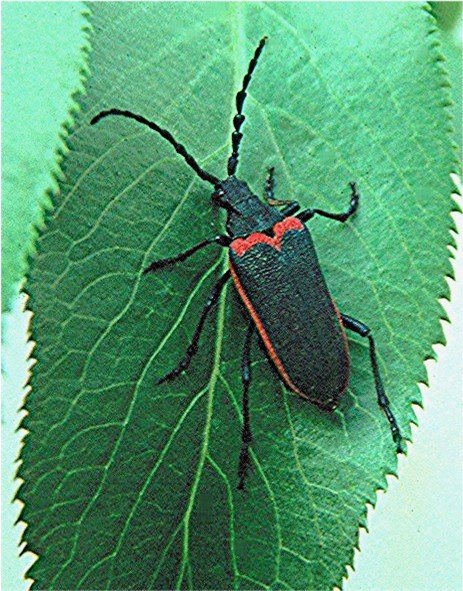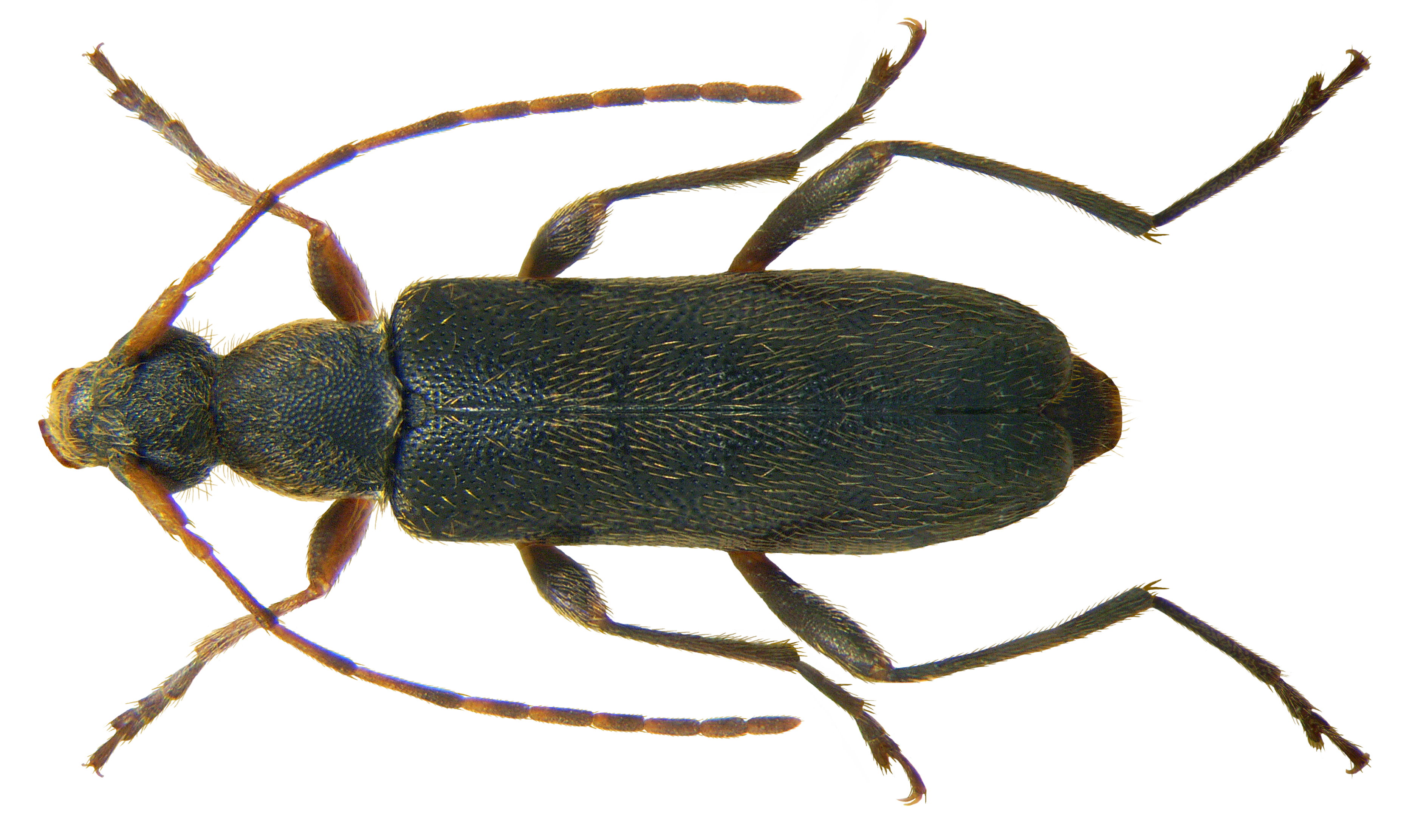Lepturinae on:
[Wikipedia]
[Google]
[Amazon]
Lepturinae, the lepturine beetles, is a



subfamily
In biological classification, a subfamily (Latin: ', plural ') is an auxiliary (intermediate) taxonomic rank, next below family but more inclusive than genus. Standard nomenclature rules end subfamily botanical names with "-oideae", and zoologi ...
of the longhorn beetle
The longhorn beetles (Cerambycidae), also known as long-horned or longicorns, are a large family of beetles, with over 35,000 species described. Most species are characterized by extremely long antennae, which are often as long as or longer than ...
family
Family (from la, familia) is a Social group, group of people related either by consanguinity (by recognized birth) or Affinity (law), affinity (by marriage or other relationship). The purpose of the family is to maintain the well-being of its ...
(Cerambycidae), containing about 150 genera
Genus ( plural genera ) is a taxonomic rank used in the biological classification of living and fossil organisms as well as viruses. In the hierarchy of biological classification, genus comes above species and below family. In binomial nomenclat ...
worldwide. This lineage is most diverse in the Northern Hemisphere
The Northern Hemisphere is the half of Earth that is north of the Equator. For other planets in the Solar System, north is defined as being in the same celestial hemisphere relative to the invariable plane of the solar system as Earth's Nort ...
. Until recently the subfamily Necydalinae was included within the lepturines, but this has been recently recognized as a separate subfamily. Nine tribes are usually recognized today, with a tenth, Caraphiini, created in 2016. A few genera are of uncertain placement within the subfamily.
Usually among the smaller members of their family, these beetles are of a slender shape – particularly the thorax
The thorax or chest is a part of the anatomy of humans, mammals, and other tetrapod animals located between the neck and the abdomen. In insects, crustaceans, and the extinct trilobites, the thorax is one of the three main divisions of the cre ...
is markedly less wide than the wings, while the elytra
An elytron (; ; , ) is a modified, hardened forewing of beetles (Coleoptera), though a few of the true bugs (Hemiptera) such as the family Schizopteridae are extremely similar; in true bugs, the forewings are called hemelytra (sometimes alterna ...
tips are often pointed. They differ from most other longhorn beetles in that the antenna
Antenna ( antennas or antennae) may refer to:
Science and engineering
* Antenna (radio), also known as an aerial, a transducer designed to transmit or receive electromagnetic (e.g., TV or radio) waves
* Antennae Galaxies, the name of two collid ...
e are not directly adjacent to the compound eye
A compound eye is a visual organ found in arthropods such as insects and crustaceans. It may consist of thousands of ommatidia, which are tiny independent photoreception units that consist of a cornea, lens, and photoreceptor cells which disti ...
s. Hence, the latter are generally oval in outline, rather than having an indentation where the antennae originate, or even being divided by them. In addition, sexual dichromatism
Sexual dimorphism is the condition where the sexes of the same animal and/or plant species exhibit different morphological characteristics, particularly characteristics not directly involved in reproduction. The condition occurs in most ani ...
is not infrequently seen in lepturines; usually, longhorn beetles are not dimorphic or only have longer antennae in males.
Tribes and genera
Lepturinae contains the following genera:

Tribe Caraphiini
* '' Caraphia'' Matsushita 1933 Noctileptura Chemsak & Linsley, 1984Tribe Desmocerini Blanchard, 1845
* '' Desmocerus'' Dejean 1821Tribe Encyclopini LeConte, 1873
* '' Encyclops'' Newman 1838 * '' Leptalia'' LeConte 1873Tribe Lepturini Latreille, 1802
Selected genera: * '' Alosternida'' Podany 1961 * '' Analeptura'' Linsley & Chemsak 1976 * '' Anastrangalia'' Ohbayashi 1963 * '' Anoplodera'' Pic 1901 * '' Bellamira'' LeConte 1873 * '' Brachyleptura'' Casey 1913 * '' Cerrostrangalia'' Hovore & Chemsak 2005 * '' Charisalia'' Casey 1913 * '' Chontalia'' Bates 1872 * '' Choriolaus'' Bates 1885 * '' Cyphonotida'' Casey 1913 * '' Dorcasina'' Casey 1913 * '' Eurylemma'' Chemsak & Linsley 1974 * '' Euryptera'' Lepeletier & Audinet-Serville in Latreille 1828 * '' Fortuneleptura'' Villiers 1979 * '' Grammoptera'' Audinet-Serville 1835 * '' Idiopidonia'' Swaine & Hopping 1928 * '' Judolia'' Mulsant 1863 * '' Leptochoriolaus'' Chemsak & Linsley 1976 * '' Leptura'' Linnaeus 1758 * '' Lepturobosca'' (Cosmosalia) Casey 1913 * '' Lepturopsis'' Linsley & Chemsak 1976 * '' Lycidocerus'' Chemsak & Linsley 1976 * '' Lycochoriolaus'' Linsley & Chemsak 1976 * '' Lycomorphoides'' Linsley 1970 * '' Lygistopteroides'' Linsley & Chemsak 1971 * '' Macrochoriolaus'' Linsley 1970 * '' Megachoriolaus'' Linsley 1970 * '' Meloemorpha'' Chemsak & Linsley 1976 * '' Mimiptera'' Linsley 1961 * '' Mordellistenomimus'' Chemsak & Linsley 1976 * '' Nemognathomimus'' Chemsak & Linsley 1976 * '' Neoalosterna'' Podany 1961 * '' Neobellamira'' Swaine & Hopping 1928 * '' Neoleptura'' Thomson 1860 * '' Orthochoriolaus'' Linsley & Chemsak 1976 * '' Ortholeptura'' Casey 1913 * '' Pachytodes'' Pic 1891 * '' Pseudophistomis'' Linsley & Chemsak 1971 * '' Pseudostrangalia'' Swaine & Hopping 1928 * '' Pseudotypocerus'' Linsley & Chemsak 1971 * '' Pygoleptura'' Linsley & Chemsak 1976 * '' Stenelytrana'' Dejean 1837 * '' Stenostrophia'' Casey 1913 * '' Stenurella'' Rosenhauer, 1856 * '' Stictoleptura'' Casey 1924 * '' Strangalepta'' Casey 1913 * '' Strangalia'' Dejean 1835 * '' Strangalidium'' Giesbert 1997 * '' Strophiona'' Casey 1913 * '' Trachysida'' Casey 1913 * '' Trigonarthris'' Haldeman 1847 * '' Trypogeus'' Lacordaire, 1869 * '' Typocerus'' LeConte 1850 * '' Xestoleptura'' Casey 1913Tribe Oxymirini Danilevsky, 1997
* '' Neoxymirus'' Miroshnikov 2013 * '' Oxymirus'' Mulsant 1862Tribe Rhagiini Kirby, 1837
* '' Acmaeops'' LeConte 1850 * '' Acmaeopsoides'' Linsley & Chemsak 1976 * '' Akimerus'' Audinet-Serville, 1835 * '' Anthophylax'' LeConte 1850 * '' Apiocephalus'' Gahan, 1898 * '' Brachysomida'' Casey 1913 * '' Brachyta'' Fairmaire 1868 * '' Centrodera'' LeConte 1850 * '' Comacmaeops'' Linsley & Chemsak 1972 * '' Cortodera'' Mulsant 1863 * '' Enoploderes'' LeConte 1862 * '' Evodinus'' LeConte 1850 * '' Gaurotes'' LeConte 1850 * '' Metacmaeops'' Linsley & Chemsak 1972 * '' Neanthophylax'' Linsley & Chemsak 1972 * '' Pachyta'' Dejean 1821 * '' Pidonia'' Thomson 1864 * '' Piodes'' LeConte 1850 * '' Pseudogaurotina'' Plavilstshikov 1958 * '' Rhagium'' Fabricius 1775 * '' Stenocorus'' Reitter 1912 * '' Tomentgaurotes'' Podany 1962Tribe Rhamnusiini Sama, 2009
* '' Neorhamnusium'' Hayashi 1976 * '' Rhamnusium'' Latreille 1829Tribe Sachalinobiini Danilevsky, 2010
* '' Sachalinobia''Tribe Teledapini Pascoe, 1871
Tribe Xylosteini Reitter, 1913
* '' Leptorhabdium'' Kraatz 1879 * '' Pseudoxylosteus'' Sama 1993''
Incertae sedis
' () or ''problematica'' is a term used for a taxonomic group where its broader relationships are unknown or undefined. Alternatively, such groups are frequently referred to as "enigmatic taxa". In the system of open nomenclature, uncertainty ...
''
* †'' Leptura longipennis'' (nomen dubium; does not belong to '' Leptura'')
References
* * {{Taxonbar, from=Q2455153 Articles containing video clips